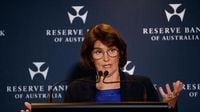The Reserve Bank of Australia (RBA) has decided to hold the official cash rate steady at 4.1 percent during its board meeting on April 1, 2025, a move seen as a response to the growing uncertainty in global trade dynamics. This decision comes just days before U.S. President Donald Trump enacted significant trade tariffs, raising concerns about inflation and economic stability in Australia.
The RBA's minutes from the meeting, released shortly after, indicate that the central bank is navigating a complex landscape where it must balance the fight against inflation with the need to maintain low unemployment. "While financial pressures remained pervasive across the Australian community, they had generally eased a little," the RBA board noted. This reflects a broader context where the bank has previously raised interest rates dramatically since 2022 to combat surging demand and push inflation back into a target range of 2 to 3 percent.
As the RBA prepares for the potential fallout from Trump's trade policies, the minutes highlight that risks to Australian inflation are two-sided. A significant depreciation of the Australian dollar could lead to higher prices for imported goods, particularly affecting everyday items like cars, clothes, and electronics. After Trump’s announcement, the Aussie dollar dipped below 60 U.S. cents but has since recovered as the president moderated his tariff proposals.
The RBA has also advised against following the U.S. lead in imposing tariffs, emphasizing that such protectionist measures could result in higher import prices and disrupt supply chains. The minutes stated, "Countries imposing tariffs could experience higher import prices, supply chain disruptions and efficiency losses resulting from tariff-induced distortions to trade patterns." This insight reflects a growing consensus among economists that tariffs could ultimately harm living standards in the long term.
As of April 14, 2025, financial markets are anticipating a rate cut in May, with many economists shifting their forecasts following the recent volatility in the markets. Initially, a dozen economists had expected the RBA to maintain rates in May, but only four held onto that view as of mid-April. ANZ senior economist Adelaide Timbrell suggested that the RBA might ease the cash rate by 25 basis points in the coming months to mitigate potential negative impacts from global trade tensions.
The RBA’s communication strategy has also drawn attention. The board's minutes revealed a desire to convey that the outcome of the May meeting is not predetermined, a statement that some analysts interpret as a signal that a rate cut is likely. Governor Michele Bullock, in a recent speech, emphasized the uncertainty surrounding future rate paths, stating, "There are a lot of moving parts. We are bringing all this together to form an objective assessment of what it means for the outlook for domestic activity and inflation here at home."
Despite the RBA's cautious stance, the economic indicators are showing some resilience. The share of borrowers falling behind on their mortgage payments has stabilized at pre-pandemic levels, and overall household liquidity remains strong. This stability is attributed to a combination of previous rate cuts, lower taxes, and rising wages.
However, the RBA has acknowledged potential vulnerabilities in the financial system, warning that lower interest rates could encourage riskier borrowing behavior. The board cautioned that, historically, periods of low rates can coincide with increased borrowing and rapid house price inflation. "While lending standards were currently sound, historical experience both in Australia and abroad suggested that periods of lower interest rates can coincide with riskier borrowing activity," the RBA noted.
Looking ahead, the RBA's next meeting on May 19-20 will be crucial. The board plans to reassess monetary policy in light of new data on inflation, wages, and economic activity, as well as the evolving landscape of global trade policies. The minutes reflect a recognition that the current economic environment is fluid, requiring careful monitoring and a willingness to adapt.
The RBA's approach underscores the challenges faced by central banks worldwide as they navigate the complexities of a global economy marked by uncertainty and shifting trade dynamics. As Australia braces for the potential impacts of Trump's tariffs and other global economic pressures, the RBA's decisions in the coming months will be closely watched by economists and policymakers alike.
In summary, the RBA's decision to hold the cash rate steady reflects a cautious approach amid significant global uncertainties. With inflationary pressures looming and a volatile economic backdrop, the central bank's next steps will be critical in shaping Australia's economic trajectory in the months to come.







